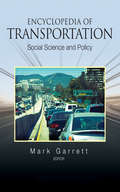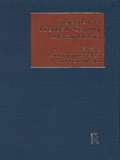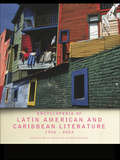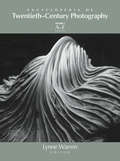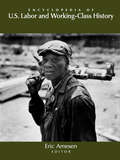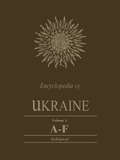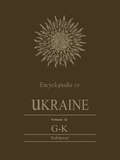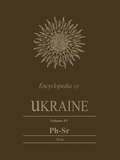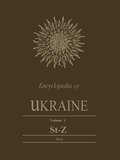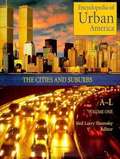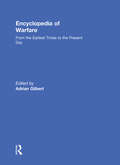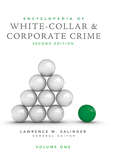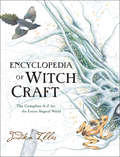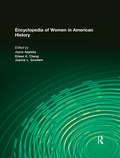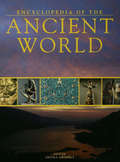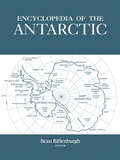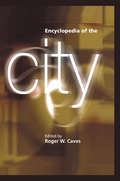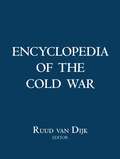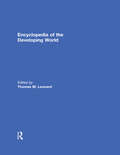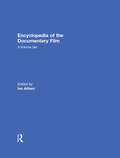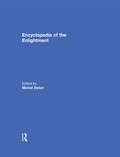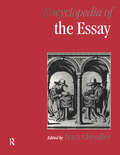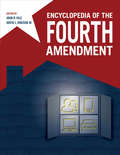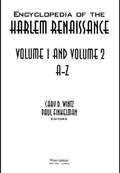- Table View
- List View
Encyclopedia of Transportation: Social Science and Policy
by Dr Mark E. GarrettViewing transportation through the lens of current social, economic, and policy aspects, this four-volume reference work explores the topic of transportation across multiple disciplines within the social sciences and related areas, including geography, public policy, business, and economics. The book’s articles, all written by experts in the field, seek to answer such questions as: What has been the legacy, not just economically but politically and socially as well, of President Eisenhower’s modern interstate highway system in America? With that system and the infrastructure that supports it now in a state of decline and decay, what’s the best path for the future at a time of enormous fiscal constraints? Should California politicians plunge ahead with plans for a high-speed rail that every expert says—despite the allure—will go largely unused and will never pay back the massive investment while at this very moment potholes go unfilled all across the state? What path is best for emerging countries to keep pace with dramatic economic growth for their part? What are the social and financial costs of gridlock in our cities? Features: Approximately 675 signed articles authored by prominent scholars are arranged in A-to-Z fashion and conclude with Further Readings and cross references. A Chronology helps readers put individual events into historical context; a Reader’s Guide organizes entries by broad topical or thematic areas; a detailed index helps users quickly locate entries of most immediate interest; and a Resource Guide provides a list of journals, books, and associations and their websites. While articles were written to avoid jargon as much as possible, a Glossary provides quick definitions of technical terms. To ensure full, well-rounded coverage of the field, the General Editor with expertise in urban planning, public policy, and the environment worked alongside a Consulting Editor with a background in Civil Engineering. The index, Reader’s Guide, and cross references combine for thorough search-and-browse capabilities in the electronic edition. Available in both print and electronic formats, Encyclopedia of Transportation is an ideal reference for libraries and those who want to explore the issues that surround transportation in the United States and around the world.
Encyclopedia of Twentieth-Century African History
by Paul Tiyambe Zeleza Dickson EyohWith nearly two hundred and fifty individually signed entries, the Encyclopedia of Twentieth-Century African History explores the ways in which the peoples of Africa and their politics, states, societies, economies, environments, cultures and arts were transformed during the course of that Janus-faced century. Overseen by a diverse and distinguished international team of consultant editors, the Encyclopedia provides a thorough examination of the global and local forces that shaped the changes that the continent underwent. Combining essential factual description with evaluation and analysis, the entries tease out patterns from across the continent as a whole, as well as within particular regions and countries: it is the first work of its kind to present such a comprehensive overview of twentieth-century African history. With full indexes and a thematic entry list, together with ample cross-referencing and suggestions for further reading, the Encyclopedia will be welcomed as an essential work of reference by both scholar and student of twentieth-century African history.Choice Outstanding Academic Title 2004
Encyclopedia of Twentieth-Century Latin American and Caribbean Literature, 1900-2003
by Daniel Balderston Mike GonzalezThe Encyclopedia of Twentieth-Century Latin American and Caribbean Literature, 1900–2003 draws together entries on all aspects of literature including authors, critics, major works, magazines, genres, schools and movements in these regions from the beginning of the twentieth century to the present day. With more than 200 entries written by a team of international contributors, this Encyclopedia successfully covers the popular to the esoteric.The Encyclopedia is an invaluable reference resource for those studying Latin American and/or Caribbean literature as well as being of huge interest to those folowing Spanish or Portuguese language courses.
Encyclopedia of Twentieth-Century Photography, 3-Volume Set
by Lynne WarrenThe Encyclopedia of Twentieth-Century Photography explores the vast international scope of twentieth-century photography and explains that history with a wide-ranging, interdisciplinary manner. This unique approach covers the aesthetic history of photography as an evolving art and documentary form, while also recognizing it as a developing technology and cultural force. This Encyclopedia presents the important developments, movements, photographers, photographic institutions, and theoretical aspects of the field along with information about equipment, techniques, and practical applications of photography. To bring this history alive for the reader, the set is illustrated in black and white throughout, and each volume contains a color plate section. A useful glossary of terms is also included.
Encyclopedia of U.S. Labor and Working-Class History
by Eric ArnesenA RUSA 2007 Outstanding Reference Title The Encyclopedia of US Labor and Working-Class History provides sweeping coverage of US labor history. Containing over 650 entries, the Encyclopedia encompasses labor history from the colonial era to the present. Articles focus on states, regions, periods, economic sectors and occupations, race-relations, ethnicity, and religion, concepts and developments in labor economics, environmentalism, globalization, legal history, trade unions, strikes, organizations, individuals, management relations, and government agencies and commissions. Articles cover such issues as immigration and migratory labor, women and labor, labor in every war effort, slavery and the slave-trade, union-resistance by corporations such as Wal-Mart, and the history of cronyism and corruption, and the mafia within elements of labor history. Labor history is also considered in its representation in film, music, literature, and education. Important articles cover the perception of working-class culture, such as the surge in sympathy for the working class following September 11, 2001. Written as an objective social history, the Encyclopedia encapsulates the rise and decline, and continuous change of US labor history into the twenty-first century.
Encyclopedia of Ukraine: A-F plus Map and Gazetteer
by Volodymyr KubijovycOver thirty years in the making, the most comprehensive work in English on Ukraine is now complete: its history, people, geography, economy, and cultural heritage, both in Ukraine and in the diaspora.
Encyclopedia of Ukraine: G-K
by Volodymyr KubijovycThe appearance of Volume II of the Encyclopedia of Ukraine makes the second stage of a major publishing project. Based on twenty-five years' research by more than 100 scholars from around the world, the encyclopedia provides the most essential information about Ukraine and its people, history, geography, economy, and cultural heritage. Volume II contains entries beginning with the letters G to K, among them numerous biographies of historical figures and people currently living in and outside of Soviet Ukraine. Included are some 600 illustrations, maps, and statistical tables. The five volumes of the Encyclopedia of Ukraine will constitute a comprehensive guide to the life and culture of Ukrainians and reflect the manifold relations of Ukrainians with their neighbours and with their non-Ukrainian environments in the various countries to which they immigrated.
Encyclopedia of Ukraine: Ph-Sr
by Danylo Husar StrukOver thirty years in the making, the most comprehensive work in English on Ukraine is now complete: its history, people, geography, economy, and cultural heritage, both in Ukraine and in the diaspora.
Encyclopedia of Ukraine: St-Z
by Danylo Husar StrukOver thirty years in the making, the most comprehensive work in English on Ukraine is now complete: its history, people, geography, economy, and cultural heritage, both in Ukraine and in the diaspora.
Encyclopedia of Urban America: The Cities and Suburbs (Volume 2, M-Z)
by Neil L. ShumskyThis monumental work provides detailed definitions and context for the many terms and names encountered while studying the development and significance of the metropolis, the megalopolis, and, of course, the newly discovered edge city (among other strains of suburb). Includes 547 entries highlighting cultural and social phenomenon; economic and political issues; environmental concerns; transportation and infrastructure; ethnic and racial groups; the role of religion; and key figures in urban politics, literature, art, and music. The editor's introductory essay discusses the definition of urban and the development of urban studies.
Encyclopedia of Warfare: From the Earliest Times to the Present Day
by Adrian GilbertThe Encyclopedia of Warfare is a chronological account of the development of warfare since the beginnings of recorded history. The book is organized in 10 chapters, each of which looks at a particular era in warfare from the ancient world to the present. Each chapter includes color maps of key campaigns, as well as commentary on battles, personalities, troops, and equipment. Sidebars throughout the main narrative focus on noteworthy aspects of the history of conflict. Through its chronological organization and ample use of maps, the Encyclopedia also clearly conveys the link between war and world geographical history. A thorough yet concise exploration of combat throughout human history, this fascinating and informative reference work is an outstanding addition to any library collection.
Encyclopedia of White-Collar and Corporate Crime
by Lawrence M. SalingerSince the first edition of the Encyclopedia of White Collar and Corporate Crime was produced in 2004, the number and severity of these crimes have risen to the level of calamity, so much so that many experts attribute the near-Depression of 2008 to white-collar malfeasance, namely crimes of greed and excess by bankers and financial institutions. Whether the perpetrators were prosecuted or not, white-collar and corporate crime came near to collapsing the U.S. economy. In the 7 years since the first edition was produced we have also seen the largest Ponzi scheme in history (Maddoff), an ecological disaster caused by British Petroleum and its subcontractors (Gulf Oil Spill), and U.S. Defense Department contractors operating like vigilantes in Iraq (Blackwater). White-collar criminals have been busy, and the Second Edition of this encyclopedia captures what has been going on in the news and behind the scenes with new articles and updates to past articles.
Encyclopedia of Witchcraft
by Judika IllesThe author of the popular Encyclopedia of 5,000 Spells and Encyclopedia of Spirits now explores the exciting magic and power of the mystical world of witches in Encyclopedia of Witchcraft, a comprehensive reference book that covers everything you ever wanted to know about this fascinating topic.Folklore expert Judika Illes introduces readers to mythic witches, modern witches, sacred goddess witches, even demon witches, male and female witches, witches from all over the globe. She takes readers on an enchanting tour through witchcraft's history, mythology, and folklore, where they will discover a miscellany of facts including magic spells, rituals, potions, recipes, celebrations, traditions, and much more.
Encyclopedia of Women in American History
by Joyce Appleby Eileen Chang Neva GoodwinThis illustrated encyclopedia examines the unique influence and contributions of women in every era of American history, from the colonial period to the present. It not only covers the issues that have had an impact on women, but also traces the influence of women's achievements on society as a whole. Divided into three chronologically arranged volumes, the set includes historical surveys and thematic essays on central issues and political changes affecting women's lives during each period. These are followed by A-Z entries on significant events and social movements, laws, court cases and more, as well as profiles of notable American women from all walks of life and all fields of endeavor. Primary sources and original documents are included throughout.
Encyclopedia of the Ancient World
by Shona GrimblyEncyclopedia of the Ancient World is a colorful and lively examination of some of the most important civilizations that have shaped our world. Each entry concentrates on a particular civilization, or series of civilizations, and combines its history with an explanation of who the people were and how they lived. An examination of respective belief systems and myths is also included. Reflecting the latest developments in archaeology and bio-geography, LEncyclopedia of the Ancient World explains how the ancient civilizations developed, and how they came to dominate their neighbors, how they evolved, and why they eventually declined or died out. Encyclopedia of the Ancient World also features 400 full-color and black-and-white photographs, as well as specially commissioned diagrams and reconstructions, that help to illuminate life as it was lived many centuries ago. The book concludes with an extensive time-line that places the civilizations in an historic context; a bibliography of suggested further reading; a glossary of useful terms; and a comprehensive index.
Encyclopedia of the Antarctic
by Beau RiffenburghThe Antarctic is unique, geographically, politically, and scientifically. It is the most remote, hostile, and dangerous continent, while at the same time it is the most pristine and least developed. Antarctica is the only major part of the Earth's landmass not directly governed by one nation, but under the control of a Treaty, with a multitude of acceding nations. The Encyclopedia of the Antarctic brings together large quantities of information on the wide variety of factors, issues and individuals influencing and relating to the Antarctic. No comparable book currently exists for this region.The Encyclopedia of the Antarctic discusses scientific activities and topics, but the 'human element' is also a significant part of the work, with entries on history, politics, legal issues, national research programs, scientific bases, historic huts, the United Nation's 'Question of Antarctica,' compliance with the Environmental Protocol, and tourism.
Encyclopedia of the Arctic
by Mark NuttallWith detailed essays on the Arctic's environment, wildlife, climate, history, exploration, resources, economics, politics, indigenous cultures and languages, conservation initiatives and more, this Encyclopedia is the only major work and comprehensive reference on this vast, complex, changing, and increasingly important part of the globe. Including 305 maps.This Encyclopedia is not only an interdisciplinary work of reference for all those involved in teaching or researching Arctic issues, but a fascinating and comprehensive resource for residents of the Arctic, and all those concerned with global environmental issues, sustainability, science, and human interactions with the environment.
Encyclopedia of the City
by Roger W. CavesThe Encyclopedia of the City focuses on the key topics encountered by undergraduates and scholars in urban studies and allied fields. Contributors include major theoreticians and practitioners, and on other individuals, groups, and organizations which study the city or practice in a field that directly or indirectly affects the city, the Encyclopedia necessarily adopts an interdisciplinary and multidisciplinary perspective. A solid but also provocative starting point for wider exploration of the city, this is a first-class work of reference that will be an essential resource for independent study as well as a useful aid in teaching.
Encyclopedia of the Cold War
by Ruud Van DijkBetween 1945 and 1991, tension between the USA, its allies, and a group of nations led by the USSR, dominated world politics. This period was called the Cold War – a conflict that stopped short to a full-blown war. Benefiting from the recent research of newly open archives, the Encyclopedia of the Cold War discusses how this state of perpetual tensions arose, developed, and was resolved. This work examines the military, economic, diplomatic, and political evolution of the conflict as well as its impact on the different regions and cultures of the world. Using a unique geopolitical approach that will present Russian perspectives and others, the work covers all aspects of the Cold War, from communism to nuclear escalation and from UFOs to red diaper babies, highlighting its vast-ranging and lasting impact on international relations as well as on daily life. Although the work will focus on the 1945–1991 period, it will explore the roots of the conflict, starting with the formation of the Soviet state, and its legacy to the present day.
Encyclopedia of the Developing World
by Thomas M. LeonardA RUSA 2007 Outstanding Reference Title The Encyclopedia of the Developing World is a comprehensive work on the historical and current status of developing countries. Containing more than 750 entries, the Encyclopedia encompasses primarily the years since 1945 and defines development broadly, addressing not only economics but also civil society and social progress. Entries cover the most important theories and measurements of development; relate historical events, movements, and concepts to development both internationally and regionally where applicable; examine the contributions of the most important persons and organizations; and detail the progress made within geographic regions and by individual countries.
Encyclopedia of the Documentary Film 3-Volume Set
by Ian AitkenThe Encyclopedia of the Documentary Film is a fully international reference work on the history of the documentary film from the Lumière brothers' Workers Leaving the Lumière Factory (1885) to Michael Moore's Fahrenheit 911 (2004). This Encyclopedia provides a resource that critically analyzes that history in all its aspects. Not only does this Encyclopedia examine individual films and the careers of individual film makers, it also provides overview articles of national and regional documentary film history. It explains concepts and themes in the study of documentary film, the techniques used in making films, and the institutions that support their production, appreciation, and preservation.
Encyclopedia of the Enlightenment
by Philip Stewart Michel Delon Gwen WellsThis acclaimed translation of Michel Delon's Dictionnaire Europen des Lumires contains more than 350 signed entries covering the art, economics, science, history, philosophy, and religion of the Enlightenment. Delon's team of more than 200 experts from around the world offers a unique perspective on the period, providing offering not only factual information but also critical opinions that give the reader a deeper level of understanding. An international team of translators, editors, and advisers, under the auspices of the French Ministry of Culture, has brought this collection of scholarship to the English-speaking world for the first time.
Encyclopedia of the Essay
by Tracy ChevalierThis groundbreaking new source of international scope defines the essay as nonfictional prose texts of between one and 50 pages in length. The more than 500 entries by 275 contributors include entries on nationalities, various categories of essays such as generic (such as sermons, aphorisms), individual major works, notable writers, and periodicals that created a market for essays, and particularly famous or significant essays. The preface details the historical development of the essay, and the alphabetically arranged entries usually include biographical sketch, nationality, era, selected writings list, additional readings, and anthologies
Encyclopedia of the Fourth Amendment
by David L. Hudson Dean John R VileCovering the key concepts, events, laws and legal doctrines, court decisions, and litigators and litigants, this new reference on the law of search and seizure—in the physical as well as the online world—provides a unique overview for individuals seeking to understand the Fourth Amendment to the U.S. Constitution. More than 900 A to Z entries cover the key issues that surround this essential component of the Bill of Rights and the linchpin of a right to privacy. This two-volume reference—from the editors of CQ Press’s award-winning Encyclopedia of the First Amendment—features a series of essays that examine the historical background of the Fourth Amendment along with its key facets relating to: Technology Privacy Terrorism Warrant requirement Congress States A to Z entries include cross-references and bibliographic entries. This work also features both alphabetical and topical tables of contents as well as a comprehensive subject index and a case index.At a time when threats of crime and terrorism have resulted in increased governmental surveillance into personal lives, this work will serve as an important asset for researchers seeking information on the history and relevance of legal rights against such intrusions. Key Features: More than 900 signed entries, including 600 court cases and 100 biographies Preface by noted journalist Nat Hentoff From the editors of CQ Press’s award-winning Encyclopedia of the First Amendment
Encyclopedia of the Harlem Renaissance
by Paul Finkelman Cary D. WintzFrom the music of Louis Armstrong to the portraits by Beauford Delaney, the writings of Langston Hughes to the debut of the musical Show Boat, the Harlem Renaissance is one of the most significant developments in African-American history in the twentieth century. The Encyclopedia of the Harlem Renaissance, in two-volumes and over 635 entries, is the first comprehensive compilation of information on all aspects of this creative, dynamic period.For a full list of entries, contributors, and more, visit the Encyclopedi a of Harlem Renaissance website.
